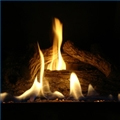
by blogediter | Feb 14, 2018 | Chimney Plugs
Vented gel burner log
Q: I have a small, 100-year-old fireplace that I do not use because the chimney is unlined and I can’t afford to get it lined. There’s no damper either. I have decided to put a fake log and an alcohol gel burner (ventless) in there for the ambiance and a small bit of extra heat. I intend to block off the top of the firebox with a steel plate and fireplace caulk. This should keep air from going up the chimney, but will not stop heat loss via radiation.
Do you think, if I installed a Chimney Balloon 4 to 6 feet above the metal plate, it would survive? These gel burners put out 3000 BTU per hour per can, and I might at times burn 3 cans at a time, for a total 9000 BTU per hour. The flames would not be high enough to touch the metal plate. Thanks, ADH
A: Dear ADH, The Chimney Balloon will trigger its release at about 180-200 degrees Fahrenheit. I am certain it will only take about 5 minutes for a couple of rocket fuel… I mean… gel fuel, canisters to get the flue temp on the other side of your metal plate up to that temp. That metal will conduct pretty well once you get it cooking.
I do want to give you a fair warning about the adaptations you are planning to do to your fireplace. This type of DIY fireplace project is what makes home insurance agents get ulcers. When you self-seals a fireplace flue with a metal plate in order to save heat you are definitely taking your chances. The heat will spill around the lintel of your fireplace and go right up to the mantle and be facing wall. When your mantel clock bursts into flames and your Hummel figurines neatly arranged on the mantle melt from the spilled heat it will be a bit too late to correct the error.
I’m being tongue-in-cheek here, but seriously, altering an existing fireplace to trap heat is not a DIY kind of thing. I don’t even know many fireplace professionals that will try it (unless it is at their in-laws). You might luck out and fix it up just right, and you might create a real safety risk. – Jason
Q: Jason, Thanks for your input about the chimney pillow and the concern about the fireplace adaptation. Before planning to do all this, I consulted specs from several manufacturers for ventless gas logs placed in existing fireplaces.
According to specs, ventless gas logs for this size fireplace, burned with the damper closed, can safely run at considerably more than 9000 BTU given the distance between the top of this particular fireplace opening (which has a hood) and the mantel. The metal plate will be in the same place a damper would be– if there was one– and dampers are metal, so I don’t see the problem. (It will only be touching firebrick and will be several inches back from the fireplace opening, also.)
A number of people in old houses here have had their fireplaces blocked off and big, honking gas logs installed without incident– seems to be standard practice around here anyway.
A: Dear ADH, I am very relieved to hear you researched it fully first, and it sounds like you covered your bases. Good luck with your fireplace project. – Jason
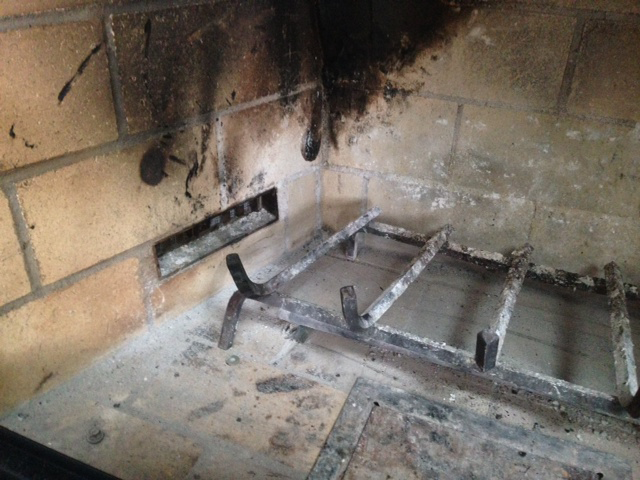
by blogediter | Feb 7, 2018 | Gas Logs
Fresh Air Vent
Q: I have a fairly new home built in 2004. I’ve noticed that my living room area is colder than the rest of the house. I always thought it was because of the patio door or maybe the vaulted ceilings and it’s a large room. There is a fireplace I never use. I just noticed today there is a draft coming through the bottom where the controls are and the tile around the bottom is ice cold. This explains why my toes are so cold when I sit on the couch and watch tv. Is there anything I can do about this? I might just put some kind of insulation sheet in front of the whole thing. thanks for your help – JP
A: JP, There is a couple of different sources that could be letting in cold air. If this is a direct vent fireplace that is mostly sealed off from access and “breaths” through tubes or pipes that go through your outside wall, then it is likely bad or no insulation around the gas lines or venting pipes. This can be remedied easily once you find the pipes. If this fireplace has a regular stack chimney and the hearth is accessible to you, it could be that the fireplace damper is clipped open or disabled in some way. Gas log fireplaces in most states have to have disabled or clipped open dampers due to fire code. The reason for this is the county doesn’t want you lighting a gas fireplace without opening the damper since this can start a fire or asphyxiate you and everyone in the home. Another possibility, in this case, could just be a worn out damper. There is a blog entry about this: http://www.chimneyballoonusa.com/blog/2007/01/welcome_to_the_.html If you find that the cold air source is coming from a disabled, or old and crusty damper and inexpensive insulation option is a Chimney Balloon. They can be bought through the manufacturer at http://www.chimneyballoon.us. They are an inflatable plug that stops air passage. Good luck finding the cold air entry point, I know from experience that cold drafts like that can be uncomfortable. – Jason
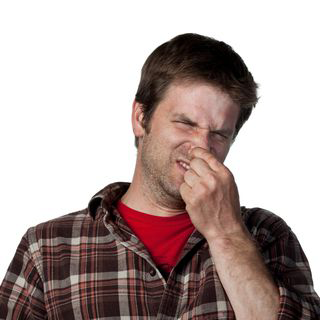
by blogediter | Feb 2, 2018 | Chimney Problems
Lingering burnt smell
Q: Dear Jason, I inflated the 15 x 15 Chimney Balloon and placed it above the damper to get rid of chimney smell. It’s much better, but I still smell it a bit after about a week. Any suggestions on how to completely get rid of the odor? Thanks, EP
A: HI EP, Fireplace odors can be tricky but here are some tips. Feel with your hand around the edges of the flue wall to make sure you have the Chimney Balloon installed as tight as possible.
If the positioning is good then it is likely that the firebox has some stinky creosote and ash residue that is creating the lingering smell. Make sure you vacuum out the firebox again really well with a shop vac. Then take a couple of boxes of baking soda and throw it all over the firebox surfaces blow the Chimney Balloon. Throw the baking soda against the firebox walls, against the damper, shake it out on the firebox floor and just basically coat everything with baking soda. If you have a hard time getting it to stick to vertical areas use a light spritz of water to get it to grab.
Let that set in your fireplace for at least 48 hours, or if you can stand the sight of it leave it for a week. The longer the better. Then shop vac all of it up. That should take care of the left-over smell. – Jason
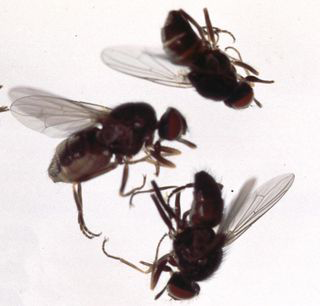
by blogediter | Jan 31, 2018 | Chimney Problems
Flies in fireplace
Flies in Fireplace
Q: Jason, I have an awful fly problem, and I think they are coming down the chimney looking to get away from the outside heat. Will the Chimney Balloon stop flies for sure? – MH
A: Hi MH, From our conversation on the phone, I was glad to hear you had your fireplace cleaned recently. Sometime fireplace flies have to do with a dead animal in the flue, or pigeons using your chimney top as an outhouse. But since you have a screened chimney top and a clean flue we can rule that out.
Flies and wasps coming down through the fireplace is a very common issue, and the Chimney Balloon does stop them. Especially in spring and fall insects follow food and other smells down into the fireplace chimney and end up inside. We get this questions so frequently there is a section of our website dedicated to it: http://www.chimneyballoon.us/bat_wasps_in_fireplace.html and some other blog articles regarding wasps as well: http://www.chimneyballoonusa.com/blog/2009/11/help-wasps-are-coming-in-through-my-fireplace-damper.html
The key to stopping flies in particular is to get an accurate measurement. Here is a section of the website that outlines how to do that measurement: http://www.chimneyballoon.us/Chimneyballoonsizing.html also you can give me a call or email pictures if you want advice on the measuring.
Once you have the measurements we need to get a Chimney Balloon for you that is as close to your measurements as possible (even if we have to go with a custom size), so you get a perfectly tight seal. Flies and maggots can be persistent in their entry techniques so you don’t want wrinkles in the Chimney Balloon from the too much extra material. – Jason
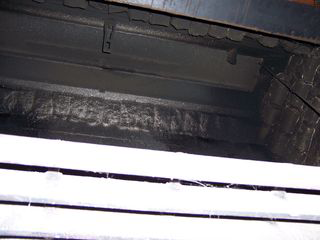
by blogediter | Jan 29, 2018 | Fireplaces
Large fireplace Frank Lloyd Wright home with pull chain damper
Large fireplace in Frank Lloyd Wright home with Chimney Balloon installed
[/vc_column_text][/vc_column_inner][vc_column_inner width=”3/4″][vc_column_text el_class=”.underlinelink , .blackh3″]Hi Jason, This is an old fireplace that is brick and masonry. When I look up the chimney I see the long rectangular metal damper door that pivots in the middle, and two pull chains [or linked pull rods] on the left and right that open and close the damper door by flipping it from horizontal to vertical like a big carburetor choke. The area below the damper is 52″x17″. How can I size a Chimney Balloon for this type of fireplace? – AE
Hi AE, From looking at the photo it looks like the damper is set up about 12 inches vertically above the termination of the lintel. This will give you enough room to put a large Chimney Balloon under the damper. I see the walls taper some on the sides, but are reasonable straight up and down in the front and back.
I recommend we go with a custom size 52″x17″ Chimney Balloon below the damper. As you inflate the Chimney Balloon the chains will be pushed off to the side and the Chimney Balloon will seal around them.
BTW, you are going to want a pump to inflate this 52×17 Chimney Balloon. It takes a lot of air to fill a Chimney Balloon of this size. – Jason
***three weeks later***
Hi Jason, I got the 52×17 Chimney Balloon in the mail a few days ago and Saturday I got it installed. Attached is a photo of the floor looking up at it.
After I inflated it I noticed that about 2 inches of the belly of the Chimney Balloon are still visible below the lintel, but since the Chimney Balloon is clear it is not very noticeable. Especially since I keep the chain spark screen closed anyway. This isn’t going to negatively affect the seal the Chimney Balloon offers, is it? – AE
Hi AE, This large of a custom Chimney Balloon will be about 12 inches tall when inflated, so it is not too surprising is protrudes below the lintel a bit. However, the Chimney Balloon is clear and the fireplace is dark so you won’t notice it.
And, no the seal will not be affected by the Chimney Balloon hanging down below the lintel a few inches. The contact seal will be on the upper side of the Chimney Balloon anyway. If you use a strong flashlight to look through the Chimney Balloon, you will see how the Chimney Balloon sealed to the walls.
Good Job BTW with the measurements and the install. You handled that application like a pro! – Jason




